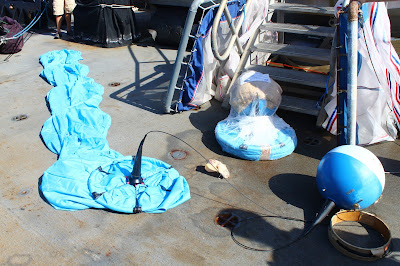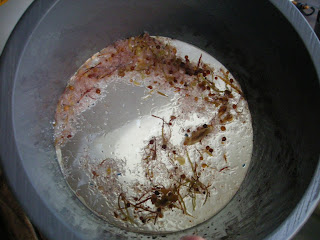 |
| Little Baby Tuna Hotsauce (homemade!) |
Well, we said goodbye to the Foster yesterday morning. We pulled into Key West around 0900, unloaded our mountain of gear, and drove back home to the Southeast Fisheries Science Center in Miami. Some of our Spanish and Mexican scientists are staying on for a few more days, as the 37th Annual Larval Fish Conference is being held in Miami starting next weekend. In fact, several of the scientists on the cruise will be presenting at the conference!
Our findings support the theory that bluefin don't normally spawn in Bahamian waters -- our total bluefin count was less than twenty (sampling in the Gulf of Mexico or the Mediterranean finds hundreds of larval tuna). The work isn't over though -- there are boxes of samples still to be sorted, and isotope/chlorophyll analyses waiting to be completed. Although it would have been exciting to find a formerly unknown spawning ground, there's a lot that can be learned from the cruise data that can help to refine current fisheries practices. There are also a lot more questions to be answered!
Thank you to all of the people who made this trip possible: The NOAA corps who handled all operations, drove the boat, and took all the station changes in stride; the mechanics who fixed the winches (and everything else) and made sure the ship was running smoothly; the stewards who kept us fed, made us Baby Tuna Hotsauce, and provided copious amounts of chocolate; the survey technicians who ran the CTDs and were great company on and off the ship; the winch operators for dealing with our many accents and radio quirks; and the electrical technicians who solved all the problems with the CTDs, radars, MOCNESS, and handled all computer business.
On a personal note: This was an incredible experience for me (I wish I was back on the ship already!). I learned a tremendous amount during the three weeks we were onboard, in addition to having a blast with everyone on the boat. It was a great group, and I couldn't have asked for a better introduction to research at sea. I now have a better understanding of why the samples I sort the rest of the year are important as well as the amount of work that goes into getting them. I'm hoping that I'll have more opportunities like this one in the future!
May the fish be with you!
 |
| Our Spanish scientist Raul out on deck |
 |
| ET (electrical technician) K. Martin and one of the survey techs S. Martin working on the small CTD |















































